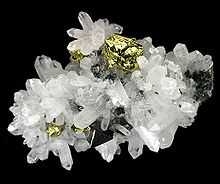Camp Bird Mine


The Camp Bird Mine is a famous and highly productive old gold mine located between Ouray and Telluride, Colorado. The mine is within the Sneffels-Red Mountain-Telluride mining district in the San Juan Mountains.
It was discovered by Thomas F. Walsh in 1896, and is (or was) owned by the Federal Resources Corp. The mine produced about 1.5 million troy ounces of gold, and 4 million troy ounces of silver, from 1896 to 1990.[1] At 2009 prices, Camp Bird's production would be worth over US$1.5 billion. Walsh sold the property for US$ 5.2 million in 1902. Walsh's daughter, Evalyn Walsh McLean, later purchased the Hope Diamond. Walsh died in 1909. His daughter Evalyn Walsh McLean devotes several chapters to the mine in her autobiography "Father Struck It Rich".
Camp Bird is named after the "Camp Birds", probably Rocky Mountain jays,[2] that ate many a miner's lunch.[3] Telluride native David Lavender related his experiences working at the Camp Bird Mine in the 1930s in his classic memoir One Man's West.
C.W. McCall sang "Way out in Colorado, in the Camp Bird Mine, down deep in the darkness, on level nine..." [4] The song moved the mine's founding to 1892 to make the rhyme work and added a ghost.
The Camp Bird Mine filed for a permit to resume mining in late 2007,[5] but remains inactive as of August 2008.[6]
See also
Notes
- ↑ Camp Bird Mine, Ouray, Sneffels District (Mount Sneffels District), Ouray Co., Colorado, USA
- ↑ Nesting of the Rocky Mountain Jay W. C. Bradbury: The Condor, Vol. 20, No. 6 (Nov. - Dec., 1918), pp. 197-208 doi:10.2307/1362801
- ↑ Camp Bird - Colorado Ghost Town
- ↑ Camp Bird Mine
- ↑ http://www.ouraynews.com/Articles-i-2007-10-12-164477.112113_Camp_Bird_filesmining_permit.html
- ↑ http://www.ouraynews.com/Articles-i-2008-08-08-182960.112113_Tom_Walsh_Road_traffic_oneway_Both_ways.html
Sources and external links
- Camp Bird ghost town, includes photo gallery
- History of the mine
| Wikimedia Commons has media related to Camp Bird Mine. |
Coordinates: 37°58′16″N 107°43′40″W / 37.97111°N 107.72778°W